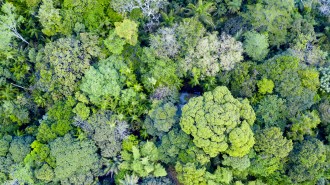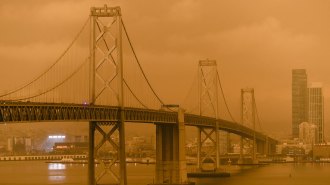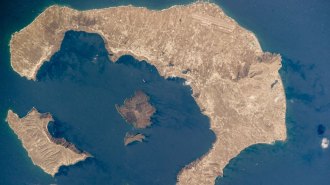Search Results
Century of Science scavenger hunt
Students will use the clues provided and the Science News Century of Science website to explore how science advances. After making connections across scientific subtopics, student groups will research and present highlights of discoveries from an assigned decade.

Earth May Be Hiding Thousands of Tree Species
In this guide, students will learn about scientists’ efforts to estimate how many tree species Earth has, analyze a related data visualization and discuss the implications the research has for conservation.
Counting Earth’s tree species
Students will answer questions about the online Science News article “Earth may have 9,200 more tree species than previously thought,” which describes researchers’ efforts to estimate the number of tree species on Earth. A version of the article, “Earth may be hiding thousands of tree species,” appears in the March 12, 2022 issue of Science News

Wildfires May Boost Urban Ozone Levels
In this guide, students will explore chemical interactions within wildfire smoke and how urban air pollution can influence the reactions.
Chemistry of wildfire smoke
Students will answer questions about the online Science News article “Wildfire smoke may ramp up toxic ozone production in cities,” which explores new research into the interactions between wildfire smoke and air pollution in cities. A version of the article, “Wildfires may boost urban ozone levels,” appears in the January 15, 2022 issue of Science News.
Where there’s smoke, there’s science
Students will discuss the composition and properties of air and wildfire smoke, and explore how substances in smoke react to ramp up a certain type of air pollution.
Thinking through climate solutions
Students will research how climate change affects a nonhuman species, propose science-based solutions that might lessen the impact of climate change on the species and create an infographic to share with the class.
Reimagining plastics recycling
Students will evaluate experimental methods for recycling plastics, gather data about the types of plastics they use at home, research plastics recycling in their community and write a letter to local officials that advocates for improving plastics recycling.

Earth Cannot Avoid a Warmer Future
In this guide, students will learn about a United Nations assessment that concludes human-caused climate change is behind extreme weather events. Then, students will discuss and compare climate scenarios and visualize some of the data.
Visualizing climate change scenarios
Students will learn about climate scenarios, analyze a chart of climate change impacts under four scenarios and create a data visualization for one climate change impact.
Looking ahead to a hotter future
Students will answer questions about the online Science News article “The new UN climate change report shows there’s no time for denial or delay,” which describes a massive scientific assessment that concludes human-caused climate change is behind extreme weather events. A version of the story, “Earth cannot avoid a warmer future,” appears in the September 11, 2021 issue of Science News.

Sea Level Dips Spur Volcanic Eruptions
In this guide, students will learn about how scientists used a computer simulation to show that sea level might influence volcanic eruptions. Then, students will discuss computer simulations and brainstorm a simulation that they could use to investigate a real-world issue.